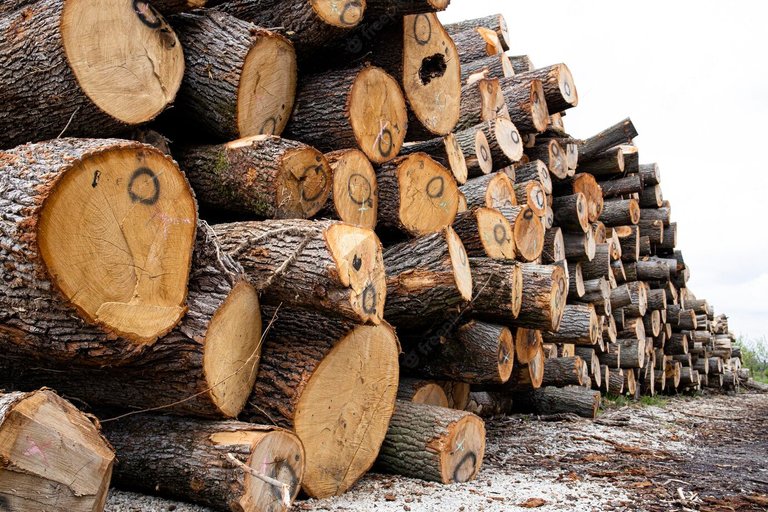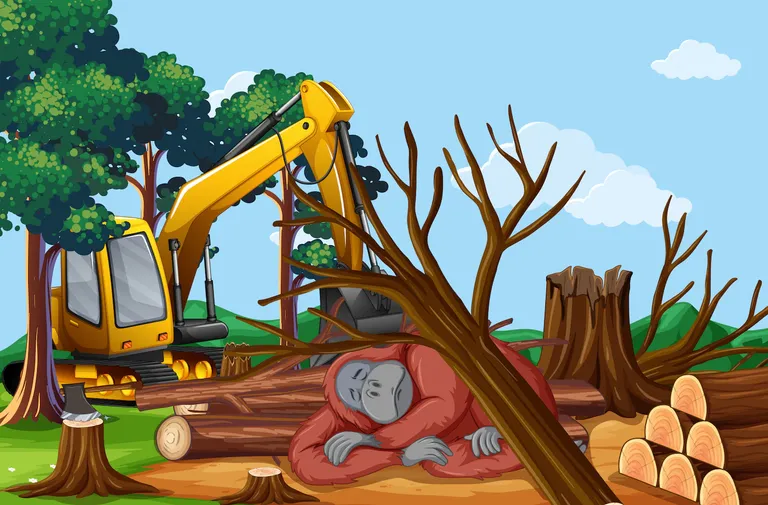Good day STEMsocial community. My name is Naza and I’m here again to write about Deforestation. Before I proceed, I just want to include in this post an appreciation to @stemng for noticing and featuring my last post on their platform here. It went a long way to encourage me and I have more confidence that people are actually reading these posts and getting some sort of awareness about our environment.
To today’s topic;
Deforestation (De-forestation) is simply the removal of forest trees from a forest land. Forest trees are cleared for different reasons like urbanization, industrialization, agriculture, mining, etc.
Deforestation is caused by both natural and human causes. Though it’s been said and it’s very obvious that deforestation is mostly human-caused. Forest fires and forest diseases can be the reason for natural forest tree loss; on the other hand, human beings clear out the forest estate for intentional purposes, for which agricultural practices is the leading reason for human-caused deforestation.
In one of my previous posts, I spoke about why forests are so important to us. I’d shed some more light on the importance of forests. Forests are responsible for the quality of air that we breathe. They are very instrumental in curbing the effects of climate change as discussed here. Trees generally have the ability to absorb a greenhouse gas called carbon dioxide from the environment, and in turn gives off oxygen which we need to survive. Why then do we remove this free gift of nature to man?
Forests also prevent removal of the upper layer of the Earth’s surface. It strengthens the soil in one piece, with its very strong roots, thereby addressing the issue of erosion.
Forests are also to be applauded for the materials that it possesses which is used by pharmaceutical companies to produce medicines, this promotes health and wellness.
Forests serve as home for wildlife. There is something called human-wildlife conflict (which I’d probably discuss more in subsequent posts). It’s a conflict that is caused by human encroachment into wildlife spaces. Deforestation is an encroachment into wildlife habitats. Wild animals live in forests, when there’s a depletion in their habitats or destruction of their habitats (their home), they tend to take refuge in the confines of our homes and that right there causes the conflict between human beings and wildlife species. It can cause loss of properties and even lives (both human and animal).
Factors that lead to deforestation
There are certain factors that lead to deforestation. They include;
- Agricultural practices: This is the major factor that leads to deforestation. The need for enough space to cultivate and grow crops especially for commercial purposes and space to raise livestock causes the clearing of the forest estate. Slash and burn method is often employed for the removal of forest trees. It results in depopulation of the forest estate. The forest trees are clear cut (a practice in forestry where all the trees are cut down in a uniform manner, usually in a large expanse of land) and the remaining vegetation is burnt down.
Subsistence agriculture is also a factor for the loss of forests. Local farmers clear out the forests so as to cultivate common crops for personal and immediate use.
Animal husbandry : This is also under agriculture. Animal husbandry is the production and management of farm animals for commercial purposes. The forest estate is removed or set on fire so as to create a grazing ground for cattle animals, such as cattle, goats, sheep, etc.
Logging activities: This is the process of harvesting, processing and moving timber from the forest to where it is needed. This could be both legal and illegal. Legal in the sense that one of the purposes of establishing a forest is to harvest from it, but at the same time sustainable forest practices should be enforced in the harvesting of forest trees. When a tree is felled, another should be planted at the same time. That way, the forest is replenished or regenerated.

Source
Whilst logging may be legal in forestry, it’s also illegal. Some people come to the forest estate and steal forest products. These people harvest forest trees without any authorization. They do not replant trees. This causes a reduction in the number of trees in the forest, leaving the forest to become an open area of land.
Firewood collection: This is another factor leading to deforestation and it is taking a toll on our forests today. Firewood is one of the major sources of many homes, especially in the rural communities. A high demand for firewood from the forest is causing a degeneration of the forest and in no distant time, there might not be enough to harvested anymore. Sustainable firewood collection should be promoted so as to ensure that the forest regains itself after collection. Not too much should be taken from the forest and also, the number taken should be equal to the number replanted.
Urbanization: This is another fast rising factor responsible for deforestation. The development and construction of infrastructure and the need for accommodating more people as the numbers are rising in urban settlements is pulling down the forests. The forest is cleared down to make room for buildings, road construction, hospitals. While this is not bad at all, it’s still posing a threat to the forest and all its many benefits.
In my opinion, there are two solutions for this problem with regards to urbanization. The first, if a particular forest location is chosen to be pulled down for construction, another area should be mapped out for afforestation (planting of trees in an area that previously did not contain forest trees). The second solution might be to balance the drift from urban to rural areas. This can be done by encouraging citizens to dwell more in the rural areas by improving the state of living in such areas. The pressure on urban establishments will reduce significantly if the condition for living in rural areas were more favorable. This will also reduce the rate at which the forest is deforested.
Impacts/Effects of Deforestation
- Climate change and global warming
As discussed in my previous post, climate change and global warming is induced by the destruction of the forest. The forest purifies the atmosphere of pollutant gases, especially excessive carbon dioxide. The forest absorbs carbon dioxide and prevents it from escaping into space.
Loss of forest trees causes a rise in global temperatures and also, when trees are cleared, they give off the carbon dioxide that they have stored up in them, adding to the already active sources of carbon dioxide in the atmosphere. This is extremely hazardous to humans. More awareness should be created about this effect that deforestation has on the environment.
Decrease in rainfall: Trees carry out evapotranspiration. Evapotranspiration is the process by which water moves to the atmosphere through evaporation and transpiration. This process is made possible through the surface of the leaves. The water that is evaporated results in cloud formation. Cloud formation is responsible for rainfall. When the forest is removed, there is no surface area for evapotranspiration to take place, causing decrease in rainfall. Also, global warming as a result of deforestation distorts the natural process of rainfall.
Flooding: The roots of trees are strong and very solid, such that when there is rainfall of high intensity, it falls into the roots of the trees and they absorb it so well, preventing runoff and flooding. But when there’s a loss of forest trees/deforestation, there’s nothing available to soak up excess water from running off into the land surface. The water holding capacity of the soil is reduced and water does not easily enter into the soil, causing flood.
- Erosion and desertification: Forest trees have strong roots that hold the soil in place. These trees support and keep the soil closely packed. Also, the leaves of the trees serve as canopy against very intense rainfall and harsh weather conditions, protecting the soil from disintegrating and preventing erosion. Another thing is that, when the leaves of trees falls to the ground it adds to the nutrients of the soil and also protects the soil. When the trees are felled, it exposes the soil to being washed away or disintegrated.
Deforestation also causes desertification. Desertification could be caused by natural and human factors. Desertification means the formation of a desert which was once a fertile land. When the forest is deforested, it becomes exposed to harsh conditions like strong wind, this strong wind makes the soil infertile and unable to support the growth of new trees, hence it turns into a desert.
- Loss of genetic resources: When forest trees are removed, the removed trees may become extinct from there. There is a reduction in the biodiversity of trees in the area. Also, the habitat of wildlife in a natural ecosystem is destroyed. This may cause migration of such animals and in the cause of the migration, wildlife species may lose their lives, causing extinction. Soil micro organisms are also affected when trees are removed.
Hope you have learnt something today? If yes, please answer the following questions in the comments section.
Questions
- What is deforestation?
- What are the causes of deforestation?
- How does deforestation cause decrease in rainfall?
- How does urbanization cause deforestation?
References
https://youmatter.world/en/definition/definitions-what-is-definition-deforestation-causes-effects/
https://bmcecol.biomedcentral.com/articles/10.1186/s12898-020-00319-1
https://www.scientificamerican.com/article/deforestation-and-global-warming/
https://www.azolifesciences.com/amp/article/What-Causes-Soil-Erosion.aspx

